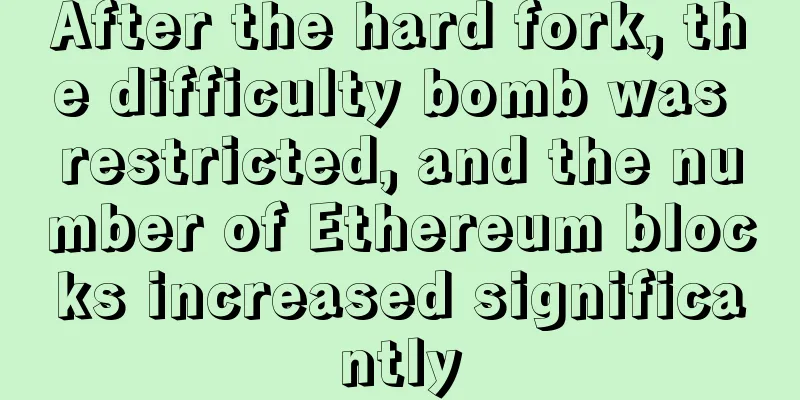After the hard fork, the difficulty bomb was restricted, and the number of Ethereum blocks increased significantly

|
According to Coindesk on March 8, after the successful Constantinople and St. Petersburg upgrades last week, the rate at which new transaction blocks are added on the Ethereum blockchain has begun to pick up again. According to data from blockchain analysis website Etherscan, within 24 hours after the Ethereum mainnet upgrade, the number of blocks generated by Ethereum per day increased by more than 1,500 blocks. (Image source: Maxpixel) The surge in block production on Ethereum is a direct result of last Thursday’s adoption of Ethereum Improvement Proposal (EIP) 1234, which aims to effectively disable a piece of code in the software, the so-called “difficulty bomb,” for 12 months. The code has been increasing the difficulty of mining on the Ethereum network and slowing down the rate at which new blocks are produced since December in order to encourage the platform to transition to a new proof-of-stake (PoS) consensus algorithm. Now, after the difficulty bomb was postponed, the situation has been reversed rapidly. Etherscan reported that within one day after the hard fork of the Ethereum network was activated, the block creation time on Ethereum was reduced from about 19 seconds to 14 seconds. Currently, Ethereum’s core developers are looking forward to a new set of Ethereum Improvement Proposals included in the next Ethereum hard fork (Istanbul). Ethereum developers have yet to determine an exact timeline for Istanbul, although former core developer Afri Schoedon said back in January that the team could potentially launch the Istanbul mainnet sometime in October. However, as Taylor Monahan, CEO of cryptocurrency wallet tool MyCrypto, emphasized in a recent interview with CoinDesk, as the ethereum ecosystem grows larger — including more companies, developers and users — it will become increasingly difficult to conduct a hard fork. Monahan said: Whenever Ethereum is about to hard fork, I get worried because there are so many factors to consider in the entire community. For example, miners, hardware or nodes, Geth, Parity, Harmony and all the different client software. In addition, there are exchanges, wallets and other factors. There are many things that can go wrong during the hard fork process. Similar concerns have been expressed by some large enterprise companies as they consider how to expand their services to include buying and selling ethereum’s native cryptocurrency, ether. Smooth activation processHowever, the entire process of hard fork activation on Ethereum went relatively smoothly. As Monahon noted, perhaps due to the upgrade team’s multiple release attempts, the majority of the community on ethereum didn’t seem to have any trouble upgrading to the new software. Ethereum blockchain analytics platform Alethio reports that the Ethereum blockchain has not seen major fluctuations in transaction volume or the number of smart contract message calls from the hard fork activation to now. Transaction counts and smart contract information on Ethereum during the Constantinople and St. Petersburg hard forks. Image credit: Alethio As can be seen on Etherscan, the hash rate on the Ethereum network (a measure of the total computing power contributed by miners to create new blocks and verify transactions) has barely changed significantly after the activation of Constantinople and St. Petersburg. This suggests that most miners on the Ethereum network have upgraded their computer servers, also known as nodes, to mine on the new chain instead of the older one. Currently, according to data from the hard fork monitoring site ForkMon, the Ethereum network hash rate is 132,986 GH/s. In comparison, miners who are still providing hashing power for the old chains that are not activated by Constantinople and St. Petersburg have a total hash rate of 1,777 GH/s. According to Martin Holst Swende, head of security at the Ethereum Foundation, due to the hash rate still available on the old version of the Ethereum blockchain, this computing power has mined a total of 19 wasted blocks since the hard fork was activated last Thursday. Swende wrote in a public statement from GitHub: These blocks were mined on the old Ethereum main chain, presumably because these miners did not update their miner software for the Constantinople fork, which is a waste of money. So while the majority of nodes on Ethereum have successfully upgraded, an important caveat that people need to be aware of is that there is still a small number of miners who have yet to migrate their hashing power to the current upgraded blockchain. Swende, the Ethereum Foundation’s security lead, urged these people in a public tweet: Miners who are mining on the old Ethereum chain, please update your software as soon as possible. |
Recommend
Scar on forehead
Scar on forehead There is a scar on the Fude Pala...
Face analysis: Will you be rich after marriage?
Face analysis: Will you be rich after marriage? E...
Is it true that people with triangular eyes are romantic?
Are triangular eyes good? In physiognomy, eyes, a...
Only with pursuit can one succeed. Introduction to moles of people with ambition
Only with pursuit can one succeed. Introduction t...
What are the characteristics of a good-looking woman? What are the facial features that make women look noble?
There are good and bad facial features. A good fac...
The Federal Reserve's hawkish stance has brought the crypto market to an abrupt halt?
Recently, the market generally expects the US to ...
How to tell the bad woman's face What are the characteristics of a bad woman's face
For some women, when others criticize them, they ...
Ethereum is increasingly vulnerable to attacks, with hashrate falling more than 42% from its all-time high
Computing power is an important indicator of the ...
Four moles on a woman's neck
Four moles on a woman's neck Mole on the neck...
How the buttocks can tell a person's fortune
From the perspective of physiognomy, the shape of...
What kind of facial features make women more likely to have affairs
For men, a woman having an affair is the greatest...
Why is the mole on the neck considered a mole of misery?
Is a mole on the neck called a mole of misery? In...
Evaluating the EU’s new definition of virtual currencies
Rage Comment : In order to combat global terroris...
The shape of your mouth can tell whether you are rich or poor
The shape of your mouth can tell whether you are ...
What are the characteristics of a wealthy face? Dimples
A rich and prosperous life sometimes seems out of...









